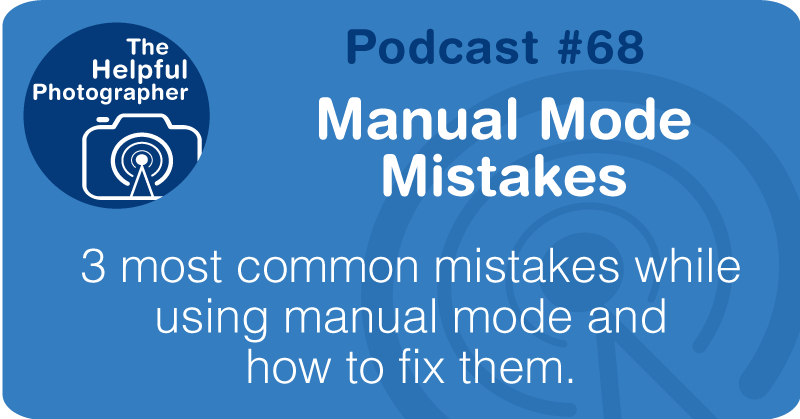Manual Mode Mistakes #68
Photo Tips Podcast: Manual Mode Mistakes #68

iTunes
Google
Audible
Tune In
Stitcher
RSS
Pandora
Transcript
Photo Tips Podcast: Manual Mode Mistakes #68
Many photographers head towards Manual Mode in an attempt to make their photos “better”. But instead, they find that their photos turn out worst. So today I’m going to talk about some of the most common mistakes photographers make when shooting in Manual mode.
The first is forgetting to change your camera settings as your environment changes. More specifically the lighting in your environment. So as you gain or lose light because you have gone from a bright place to a dark place or vice versa, you must compensate for this change either through your aperture, shutter speed or ISO or a combination of these things.
When photographers use manual mode, too often they’re fixing their cameras on one shutter speed and then simply move their aperture around that without ever reconsidering their shutter speeds as they change their lenses or zoom in and out. Putting aside the issue of the motion of your subject, this is really a bad idea unless you’re shooting static objects with a prime lens. The reason this is bad is because if you want a sharp image your shutter speed should be at least one over your focal length for most people. If you are shooting a zoom lens, which what the vast majority of photographers are doing, you have to move your shutter speed to match your focal length. In other words your shutter speed needs to be faster when shooting 200 mm then when you’re shooting 50 mm. This is obviously true for both prime and zoom lenses. So if you are shooting prime lenses you need to check where your shutter speed is when you change lenses; with a zoom lens you’ll need to check constantly as you zoom in and out. I find that most amateur photographers are using too slow of a shutter speed for their particular focal length. So why not just leave it on a really fast shutter speed? Shooting a shutter speed faster than you require means that you will need to compensate for the loss of light elsewhere and that’s usually going to be ISO, which likely means drop in resolution. Also, when adjusting shutter speed for focal length, you have to calculate for cropped sensors, the failure to do this is one of the most common mistakes. For more shutter speed issues check out my upcoming podcast on shutter priority.
Then there’s the ISO, most of the time when shooting in manual mode most amateur photographers are shooting in a static ISO. Don’t get me wrong, this isn’t a bad thing, I do it all the time. But what’s bad, is forgetting to move your ISO when lighting conditions change. When heading into dark conditions you know that you’ll need to open up your aperture and/or slow down your shutter speeds, but the fact is you’ll hit a wall with aperture fairly quickly and most will keep slowing down their shutter speeds forgetting to account for hand shake which equals a bad photo. In the past few years, since manufacturers introduced Auto ISO in a Manual Mode, I have come to find that many amateurs have embraced this. The problem with shooting with Auto ISO in a manual mode is that you’re relying on your ISO to get you to a good exposure regardless of where you have put your shutter speed and aperture, and regardless of how much available light there is. So why is getting a guaranteed good exposure bad? I know the idea of getting a guaranteed exposure can be very enticing, but failing to consider the consequences is where this falls apart. For instance, let’s say you’re shooting a very high aperture while shooting a fast shutter speed in low light with Auto ISO. What this means that the ISO will go through the roof to compensate for all three of those problems. And so the result in very poor resolution. Although your images are going to look great on that 2” LCD on the back of your camera, what’s going to happen is you’re going to take that picture and you’re going to put it on your 27” screen and realize that you have a massive resolution issue. And at that point it’s too late to fix the problem. I also want to be clear that there is a time and a place to use Auto ISO with Manual mode, but those are very narrow situations. So if you are going to do this, do be aware of your ISO. So when you’re hand holding and shooting in Manual Mode you’re the one who must constantly take 4 separate variables into consideration all at the same time. And the variable called light is usually something that is constantly changing and you can not control. Trying to create a short cut by making one or two of the other three variables static can cause significant problems. This kind of thinking can really only happen in a studio setting where you have total control over your light. So, when shooting in manual mode be sure to keep track of your shutter speeds and your ISO in particular.











